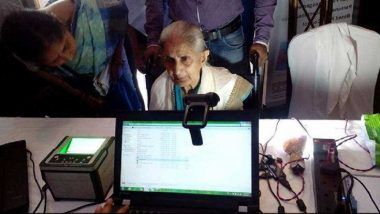New Delhi, January 15: In a bid to enable easy authentication of Aadhaar, the Unique Identification Authority of India (UIDAI) has decided to introduce another landmark technology for identification- the face authentication feature to safeguard privacy. Aadhaar authentication is a process by which the Aadhaar number along with the demographic information or biometric information of an Aadhaar number holder is submitted to Central Identities Data Repository (CIDR) for its verification.
This latest move will benefit people who have been facing issues in other forms of biometric verification, like fingerprint and iris scanning. As per reports, the facility is being allowed only in a "fusion mode" that is along with other existing means of authentication and will be available by July 1, 2018. The move comes days after the last week when it allowed individuals to create and use a virtual ID to avoid sharing their unique identity numbers when using government and other services.
@UIDAI introduces yet another landmark technology for authentication - Face Authentication. #AadhaarFaceAuth will help all elderly or others facing issues with fingerprint authentication. Service to be launched by 1 July 2018.
— CEO UIDAI (@ceo_uidai) January 15, 2018
At present, there are in all two modes of biometric authentication, fingerprint authentication and iris authentication. The Unique Identification Authority of India (UIDAI) said, "This facility is going to help in inclusive authentication of those who are not able to biometrically authenticate due to their worn-out fingerprints, old age or hard work conditions”.
The UIDAI further added saying that the face authentication provides an additional option for all residents to have inclusive authentication. It shall be allowed only in fusion mode along with one more authentication factor combined with either fingerprint or iris or OTP to be able to successfully authenticate an Aadhaar number holder.
How will the face authentication work:
- The Face Authentication provides an additional option for Authentication User Agencies (AUAs) to ensure that inclusive authentication is offered to all residents.
- The Face Authentication will ONLY be allowed in fusion mode along with one more authentication factor. This means Face authentication must be combined with either fingerprint or iris or OTP to be able to successfully authenticate an Aadhaar number holder.
- From March 1, users will have the option of generating a 16-digit virtual identity mapped to their Aadhaar number. This ID can be shared with telecom companies and others at the time of authenticating their identity.
- From June 1, 2018, it will be compulsory for all agencies, which undertake authentication, to accept the virtual IDs from their users.
- The same for SIM cards has been mandated to establish the identity of mobile phone users.
As per reports by PTI, the new feature will be allowed only when combined with "one more authentication factor", like fingerprint, iris or OTP. "This facility is going to help in inclusive authentication of those who are not able to biometrically authenticate due to their worn-out fingerprints, old age or hard work conditions," UIDAI was quoted by PTI.
Nearly, 119 crore biometric identifiers have been issued so far, and Aadhaar is required as an identity proof of residents by various government and non-government entities, PTI reported. The UIDAI- the Aadhaar issuing body on Monday said that the face authentication provides additional option for all residents to have inclusive authentication. “It shall be allowed only in fusion mode along with one more authentication factor combined with either fingerprint or iris or OTP to be able to successfully authenticate an Aadhaar number holder," UIDAI said.
(The above story first appeared on LatestLY on Jan 15, 2018 05:24 PM IST. For more news and updates on politics, world, sports, entertainment and lifestyle, log on to our website latestly.com).













 Quickly
Quickly


